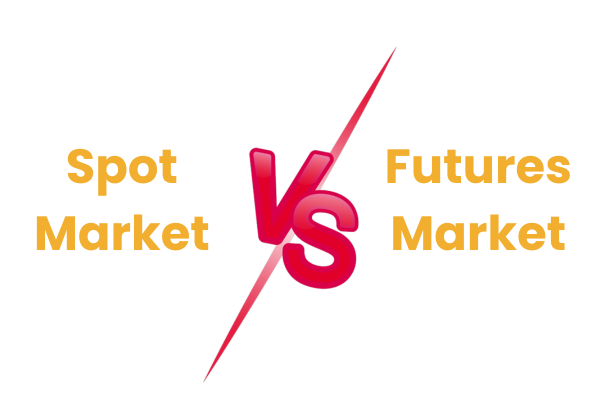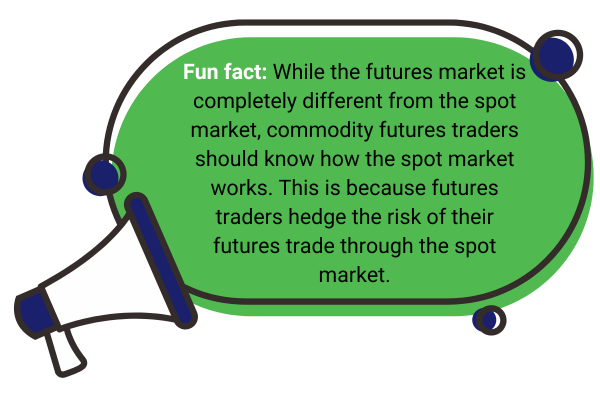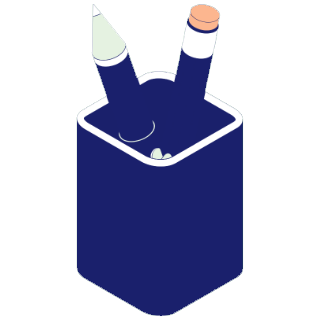Commodity Markets: Spot vs. Futures
Published: June 05, 2024

Want to grow your capital by trading commodity products like gold, crude oil, and wheat? Well, you can do so by participating on the spot (cash) or futures markets—or even both simultaneously!
These two are the primary markets where you can use your investment strategy of using commodities as your financial assets.
But how do these two markets differ, and how are assets traded on these? This lesson is your walkthrough of the concept of the spot and futures market.
Lesson Highlights:
- The spot market and futures markets are the two major marketplaces for financial traders to buy and sell commodities. The main difference is the delivery of assets and payment to both parties in the trade.
- The spot market is also known as the cash market. This is where traders buy and sell assets for immediate delivery to take advantage of the prevailing market or spot price.
- Participating in a futures market involves trading commodities on derivatives or contracts. This type of trading aims to profit from the future price of the underlying asset.
- Derivative trading uses a contract of agreement between the buyer and seller. This contract signifies the parties’ responsibility to buy and sell the underlying asset on or before it expires.
Spot Market vs. Futures Market
There are two ways you can buy and sell commodities in the financial market.You can buy or sell commodities for immediate delivery on the spot market or buy or sell the assets on a future date, hopefully at a better price.
When you’re in the spot market, the exchange of commodities is done using cash; hence, it’s also called the cash market. Due to its instant delivery, your trade uses the spot price of the market or the best available price during the trade execution.
On the other hand, traders who buy and sell on the futures market aim to profit from the future market price of the underlying asset. This future trade execution is made possible by derivatives or contracts.
This derivative or contract signifies the obligation of the buyer and seller to deliver the assets to one another on or before the contract expires.

Spot Trading to Offset Futures Risk
If you have a long position in the futures market, you might enter a counter position in the spot market to hedge or offset your exposure.For example, you're long on a futures contract as you expect the market to rise. You could take a short position in the spot market to lock in a specific price or to mitigate potential losses from adverse price movements in the futures market.
For your reference, here are the considerations that set the spot market and futures market apart.
| Consideration | Spot Market | Futures Market |
| Commodity Price | Best available or spot price | Future price |
| Fees | Low spread | High spread |
| Method | Cash-to-commodities | Derivatives contract and usually cash settlement |
| Best For | Scalpers Day traders Intraday traders |
Swing traders Position traders |
What Is a Spot Market?
In commodity trading, the spot market is where you trade commodity products... well, on the spot.This is a marketplace where you can buy or sell financial assets and expect an immediate delivery of goods and payment. However, immediate doesn’t constitute instant delivery.
The delivery in this type of market happens in less than a month, which is much shorter than holding to a futures position.
Many traders and investors refer to this market as the cash market because it involves cash-to-commodity transactions. This type of transaction involves the usage of cash to buy the commodity product or receive cash upon selling a commodity.
Commodity spot trading allows speculators and institutions to buy bulks of commodity products at short notice. This way, they maximize the best available price to grow their investment.

How Commodity Spot Trading Works
Spot trading is a commodity-cash exchange. If you buy an ounce of gold, you expect to receive actual gold in exchange for your money.The price you’ll have to pay on this market is the spot price of the commodity you want to buy.
Participants in the spot market include producers or institutions and speculators:
- Speculators: These market participants aimed to profit from the market fluctuation of a specific commodity market.
- Institutions: These commercial customers and investors buy commodities for their production and investment.
What Is a Futures Market?
The primary risk in online trading is market volatility.However, you can manage risk by hedging your trade against market volatility by trading futures. This is done by entering into contracts or agreements to buy or sell the commodity asset at a contracted price on a future date.
Doing so allows commodity traders to lock in prices and reduce the price risk, which can ruin their trade positions.
How Commodity Futures Trading Works
As mentioned, the delivery of your trade doesn’t happen immediately in the futures market. That’s because you trade futures aiming to profit from... well, the future price!But when will the trade delivery happen? It depends on the contract or agreement between you and the other trade party.
Because futures trading is contracted, it’s standardized in terms of quantity, quality, and delivery date. This makes the futures market highly liquid and tradable.
Another aspect of futures trading that attracts traders is its ability to leverage their position. With leverage, you can control and profit from big positions using small capital.
However, leveraging your trade is risky because it amplifies the potential loss if the market goes against your position.
On the expiration day, you should settle the delivery through cash settlement, where both parties pay the difference between the contract price and the market price.
Commodities Lesson Outline

- Lesson 1: A Guide to Commodity Trading
- Lesson 2: How Commodity Trading Works
- Lesson 3: Major Commodities You Can Trade
- Lesson 4: Commodity Markets: Spot vs. Futures
- Lesson 5: The Importance of Gold to Online Trading
